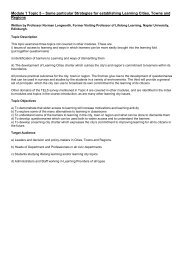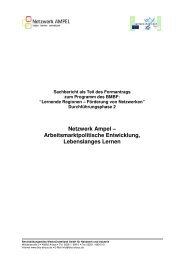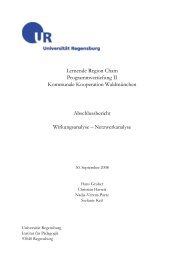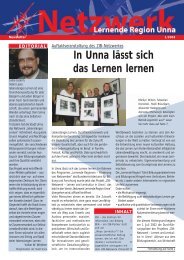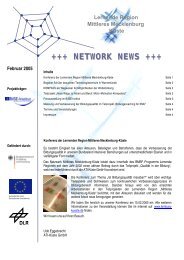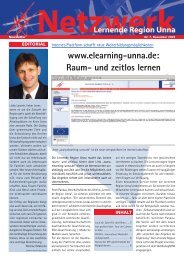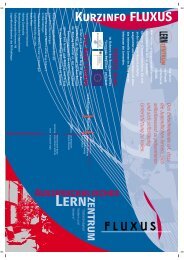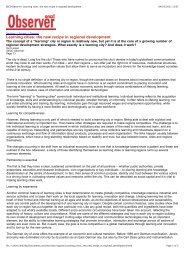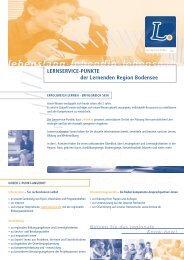SWOT-analysis as a basis for regional strategies - EUROlocal
SWOT-analysis as a basis for regional strategies - EUROlocal
SWOT-analysis as a basis for regional strategies - EUROlocal
Create successful ePaper yourself
Turn your PDF publications into a flip-book with our unique Google optimized e-Paper software.
As well <strong>as</strong> viewing the undertaking of a <strong>SWOT</strong> from the learning perspective, the<br />
implementation of the <strong>SWOT</strong> <strong>as</strong> a method will be central to the evaluation undertaken<br />
here. The stages of implementing a <strong>SWOT</strong> <strong>analysis</strong> include:<br />
• A scan of the inventory of the programme: the detection of the major trends<br />
and problems likely to affect the future of the territory through a consideration<br />
of a number of important socio-demographic, economic, political and physical<br />
indicators. The aim here is limited to the attainment of an overall picture<br />
illustrating the key issues the community in question will have to face.<br />
• Creation of an inventory of possible actions.<br />
• External <strong>analysis</strong> of opportunities and threats: a list of parameters of the<br />
environment which are not under the direct control of the public authorities,<br />
and which will strongly influence socio-economic development.<br />
• Internal <strong>analysis</strong> of strengths and weaknesses: an inventory of the factors<br />
which are at le<strong>as</strong>t partly under the control of the public authority, and which<br />
may either promote or hinder socio-economic development.<br />
• Cl<strong>as</strong>sification of possible actions.<br />
• Evaluation of a strategy, producing a portfolio of activities, containing a set of<br />
interventions, some of which link up strengths and opportunities while others<br />
try to compensate <strong>for</strong> weaknesses or to counteract threats. Interventions are to<br />
be placed along two axes: internal fe<strong>as</strong>ibility, strengths and weaknesses, and<br />
external environment, opportunities and threats. (European Commission 1999:<br />
44.) 2<br />
The nature of the strategic cycle that emerges within the <strong>SWOT</strong> itself is not only<br />
continuous, but also a deeply path-dependent process, i.e. dependent on previous<br />
strategic, political and social choices. Although on a superficial level <strong>SWOT</strong> seems to<br />
be primarily a descriptive exercise, its role <strong>as</strong> part of the process of strategic and<br />
politico-economic decision making within the region in question cannot be<br />
overlooked. This is the c<strong>as</strong>e despite the fact that on the <strong>for</strong>mal level (<strong>as</strong> indicated by<br />
the European Commission’s methodological planning instruments, <strong>for</strong> instance)<br />
<strong>analysis</strong> tends to emph<strong>as</strong>ise the more descriptive characteristics of the process.<br />
Within the context of the new Structural Funds period (2000-2006) the guidelines <strong>for</strong><br />
the European Regional Development Fund (ERDF) set certain pre-requisites, which<br />
need to be taken into account when programmes are initiated and <strong>for</strong>med into a (draft)<br />
Single Programming Document (SPD). These include the undertaking of a <strong>SWOT</strong><br />
<strong>analysis</strong> <strong>as</strong> stated in the methodological documentation (Vademecum), included in the<br />
relevant literature in this study. This includes the <strong>analysis</strong>, verified in the ex-ante<br />
evaluation of the strengths and weaknesses, <strong>as</strong> well <strong>as</strong> the disparities, gaps and<br />
beyond the pilot ph<strong>as</strong>e, such an extension could include a series of interviews with key actors in the<br />
strategy <strong>for</strong>mation process, <strong>as</strong> well <strong>as</strong> more elaborated modelling of strategy <strong>for</strong>mation within <strong>regional</strong><br />
development programmes.<br />
2 At le<strong>as</strong>t on a superficial level the European programmes are mindful of the practical applicability of<br />
the me<strong>as</strong>ures. In national <strong>regional</strong> programmes the portfolio of available activities often risks<br />
remaining at a strategic, quite un-concrete level. Though it is undoubtedly true that the elaboration of<br />
more detailed project outlines and further specified timetables would contribute to bringing the level of<br />
activity onto a more concrete level, this is rarely the c<strong>as</strong>e in strategy documents.<br />
19



